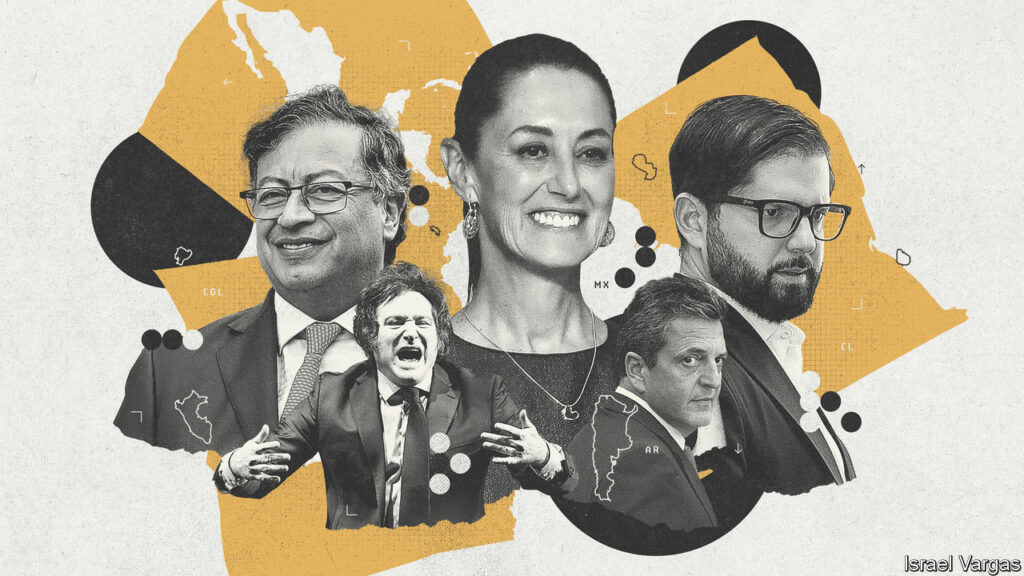By Satyaki Chakraborty
The Latin American politics is once again witnessing a big turmoil with the left wing resurgence in 2021 and 2022 getting a big setback at the fag end of 2023 as two countries Argentina and Ecuador elected right wing Presidents as against the strong left candidates. For Left, the defeat in Argentina of the ruling Peronist candidate Sergio Massa at the hands of the far right Javier Milei in the presidential run off on November 19, was a big jolt. In Ecuador also, the veteran left coalition candidate Luis Gonzalez was defeated by a 35 year old greenhorn Daniel Noboa, the heir of the biggest banana empire of the country.
As the year 2023 approaches its end and 2024 begins, the political focus is again put on the presidential elections to the five countries of the continent – Mexico, Uruguay, El Salvador, Panama and Dominican Republic. Out of these five, Mexico and Uruguay are having Left leaning presidents while the three others are having presidents with different shades of Right.. The Left defeat in the year end presidential elections has emboldened the anti-Left forces in the region and there are efforts for the consolidation of right forces.
Despite the two Left defeats, on the whole, the Latin American region is currently ruled by more Left leaning governments than the Right. The leaders of the Left resurgence are Mexico and Brazil led by two highly respected presidents Lopez Obrador or AMLO and Lula respectively. Presently, out of the 21 countries in the continent, the Left has governments in eleven including Mexico, Brazil, Chile, Peru, Bolivia, Colombia, Nicaragua, Venezuela, Honduras and Uruguay. Cuba remains a communist led nation since 1959 when Fidel Castro successfully carried out the revolution against the dictator Batista.
As against this, the Right dominated governments include Argentina, Ecuador, El Salvador, Paraguay Dominican Republic and Panama. Costa Rica has a government led president Rodrigo Chaves Robles of Social Democratic Progress Party. This Party takes a populist anti-establishment line different from both left and right. Generally, the right wing led governments get support from the US government and the multinational corporations, but in the recent months, the talk of collaboration among the Latin American nations economies to get maximum benefits by utilization of natural resources has caught the attention of the right wing regimes also. There is some churning. Haiti and Puerto Rico are two other countries under US influence.
In October 2022, the biggest victory of the Left was in Brazil when the former president Lula defeated the far right incumbent president Jair Bolsonaro in a close fight and officially took over the presidency on January 1 this year. In the last eleven months, the popular president introduced a large number of measures in favour of the underprivileged and brought about a sea change in the standard of living of the poor and the low paid workers. The new president took lead in organizing the conference of the Latin American nations and along with the Mexican president Andres Manuel Lopez Obrador, popularly known as AMLO brought about radical change in the approach of the nations towards utilizing the natural resources of the country. President Lula has emphasized on the cooperation of the Latin American countries in making optimum use of their respective strengths for joint manufacturing.
Right now, the Morena coalition ruling Mexico is considered the left wing government which has the best record in serving the people and this performance of the Mexican government during the last five years has given a big boost to the left parties in other Latin American countries. All the left wing governments are taking the Mexico performance as their model and the Mexican performance is under discussion at all developmental forums concerning Latin America these days.
On August 10 this year, Mexico’s National Council for the Evaluation of Social Development Policy (CONEVAL), an independent federal agency, released its much-awaited poverty measurements for 2022. Its findings outstripped the most optimistic forecasts: the multidimensional poverty rate in Mexico — a measurement of income plus a series of social rights such as food, housing, and education — fell 5.6 percent from 2018 to 2022, translating to some 5.1 million people. When compared to the height of the pandemic, the numbers are even more dramatic, with 8.9 million being lifted out of poverty over the last two years.
Other statistics from the report, together with findings from the National Institute of Statistics and Geography (INEGI), were equally promising. The income gap between the top and lowest 10 percent of incomes is down from twenty-one times (2016) to fifteen times (2022), while the Gini coefficient has dropped from 0.448 to 0.402 over the same period.
The divide between the lowest- and highest-income states has been squeezed by 20 percent, an important indicator in a country with a historic north/south divide. Another crucial divide, rural/urban, has also been ameliorated by a 17 percent rise in household incomes in the countryside. What is more, the highest income gains have come among women and those in the most precarious employment, such as agriculture and the informal sector in general.
Despite the impressive gains of recent years, Mexico remains a country with forty-seven million poor and eighty-five million with deficits in at least one of the multidimensional categories. In a sense, the floor being as low as it was, the “easiest” part is behind Mexico’s Fourth Transformation and its party, MORENA. Ahead of it now is a road of continuing to increase wages and labour rights while attacking intransigent structural problems such as health care: something that will be virtually impossible without a progressive tax reform which is the focus of the AMLO presidency now. Mexico is on right path to establish a welfare state and that has strengthened the cause of left programme in the region.
Seasoned political observers of the Latin American Left are quite confident about the impact of the performance of both Mexico and Brazil on the 2024 presidential elections, but they are worried at the deterioration of the economies in some of the other Left regimes. The defeat in Argentina was primarily due to the unprecedented inflation rate of 140 per cent and the instability of the Argentina currency.. The precarious economic situation angered the working class and the trade unions. A good section of the traditional supporting base of the Peronists voted for the far right candidate Javier Milei. In Ecuador, the situation is different. Though the Left candidate Luis Gonzalez has lost, her party is confident that the new president of the far right Noboa with little experience in government functioning will be able to do anything substantial to revive the economy in the next eighteen months. His term is up to May 2025. So there is no despondency among the Ecuadorian Left. That way, the Left is now focusing more concentration on the economy so that the living conditions for the citizens improve substantially by the time the presidential polls are held in the five nations in 2024. (IPA Service)


 Yogi Govt’s Ban On Halal Certification Is Aimed At Attracting Hindu Votes
Yogi Govt’s Ban On Halal Certification Is Aimed At Attracting Hindu Votes 